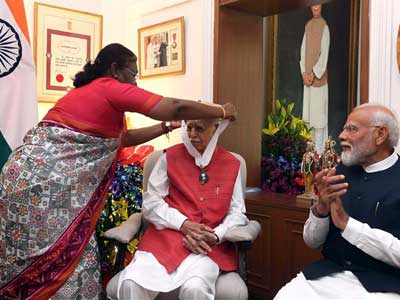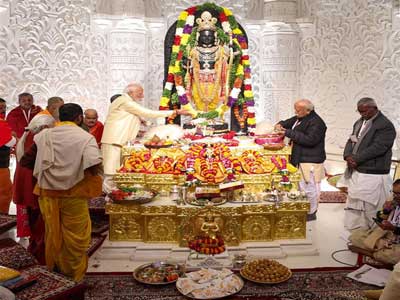In the age of digital revolution, India's highways are no longer just stretches of asphalt and concrete; they are evolving into intelligent backbones of mobility and data, enabling seamless transport and real-time information flow.
The vision of smart networks is reshaping how we travel, transport goods, manage tolls, and even access the internet on the move. Once seen merely as physical connectors between cities and states, the country’s highways are now being reimagined as smart corridors of connectivity and control, designed not just for vehicles, but for data, communication, and real-time decision-making.
The scale of this transformation is as vast as the network itself. As of March this year, India’s road network stands at more than 63 lakh kilometres, the second largest in the world. Within this, the National Highway network has grown to 1,46,204 kilometres, up from 91,287 kilometres in 2013–14, a remarkable increase of about 60 per cent. Between 2014 and 2025 alone, the country has added 54,917 kilometres of new national highways, a feat that reflects not only construction prowess but also a pressing need for digitally enabled management and monitoring of such a massive asset.
In a sweeping move to enhance efficiency and streamline operations, the government has adopted a comprehensive 360-degree digital transformation across all major phases of a highway project's lifecycle. From planning and detailed project reports to construction, maintenance, tolling, and network upgradation, core processes are being streamlined to enhance system performance and promote ease of doing business.
From paper tickets and cash booths to seamless, sensor-driven travel, India’s national highways are undergoing a quiet revolution. In a bid to cut down on wait times, reduce fuel wastage, and plug revenue leakages, the country has been steadily overhauling its toll collection system with digital-first solutions.
To streamline toll collection across India’s highways, the National Payments Corporation of India has developed the National Electronic Toll Collection program, a unified, interoperable platform for electronic toll payments. The system facilitates smooth transactions through a centralised clearing house for settlements and dispute resolution.
At the core of NETC is FASTag, a Radio Frequency Identification-based device affixed to a vehicle’s windscreen. It allows toll payments to be made automatically from the user’s linked account without stopping at the plaza. With standardised processes and specifications, FASTag ensures that commuters can use a single tag at any toll booth across the country, regardless of the operator managing the toll plaza. With a penetration rate of approximately 98 per cent and more than eight crore users, FASTag has transformed the Electronic Toll Collection system across the country.
Offering a hassle-free way to travel across India’s highways is the FASTag Annual Pass. Designed for non-commercial vehicles, the pass provides unlimited convenience with a one-time payment of ₹3,000, valid for one year or 200 toll plaza crossings across 1,150 toll plazas on National Highways and Expressways. Activated within two hours via the Rajmargyatra app or NHAI website, the pass eliminates frequent recharges, ensuring a seamless and efficient travel experience for highway users.
The FASTag Annual Pass crossed the benchmark of twenty-five lakh users with around 5.67 crore transactions recorded in two months after its launch on 15th August this year across the country, reflecting strong demand for hassle-free toll payments.
To push digital payments and reduce cash transactions at toll plazas, the government has amended the National Highways Fee Rules, 2008, effective November 15. Under the revised rules, non-FASTag users paying tolls in cash will be charged double the standard fee, while those opting for UPI payments will pay 1.25 times the toll amount. The aim is to streamline toll collection, cut down congestion, and promote greater transparency and ease of commuting on National Highways.
In August, India launched its first Multi-Lane Free Flow tolling system at Choryasi Fee Plaza on NH-48 in Gujarat, a barrier-free, camera- and RFID-based setup that reads FASTag and vehicle numbers in motion. The system allows seamless toll collection without stopping, cutting congestion, saving fuel, and reducing emissions.
In a move to redefine highway travel across India, the government launched Rajmargyatra, a citizen-centric mobile application aimed at enhancing the overall experience of commuters on national highways. Developed with user convenience at its core, the app is seamlessly integrated with a web-based system for real-time updates and efficient grievance redressal.
Rajmargyatra serves as a digital travel companion, offering a wealth of information such as details about highways, toll plazas, nearby amenities, including petrol pumps, hospitals, EV charging stations, and even live weather updates. This comprehensive data helps citizens make informed travel decisions and plan their journeys more effectively.
To facilitate a smoother driving experience, the app is integrated with FASTag services for hassle-free toll payments and supports multiple languages, ensuring wider accessibility. Prioritising safety, it also features speed limit alerts and voice assistance, promoting responsible driving habits on long stretches of road.
A standout feature of the platform is its user-friendly complaint system. Travellers can quickly report highway-related issues such as potholes, maintenance concerns, unauthorised structures, or safety hazards by uploading geo-tagged photos or videos and tracking the progress of their complaints. This not only improves accountability but also enhances transparency in the management of road infrastructure.
The Rajmargyatra app has rapidly gained traction among Indian commuters, climbing to the 23rd spot in the overall rankings on Google Play Store and securing the 2nd spot in the travel category. With over 15 lakh downloads and an impressive user rating of 4.5 stars, the app has emerged as a popular digital tool for highway travellers across the country. In a significant achievement, Rajmargyatra also became the top-performing government app just four days after the launch of the FASTag Annual Pass feature, marking a major accomplishment in its adoption and impact.
To boost operational efficiency and ensure the timely execution of infrastructure projects, the National Highways Authority of India has launched the ‘NHAI One’ mobile application, a comprehensive platform that streamlines internal processes and enhances on-ground coordination across the national highway network.
NHAI One integrates five core areas of NHAI’s project operations: Field Staff Attendance, Highway Maintenance, Road Safety Audits, Toilet Maintenance, and Daily Construction Audits via Request for Inspections. By consolidating these functions into a single digital interface, the app empowers field teams and supervisory personnel to manage tasks more effectively and in real-time.
From Regional Officers and Project Directors to contractors, engineers, safety auditors, and toilet supervisors at toll plazas, the app enables last-mile users to report, update, and track project-related activities directly from the field. With features like geo-tagging and time-stamping, NHAI One enhances accountability and ensures accurate documentation of on-site progress and compliance.
Beyond improving internal efficiency, the app plays a key role in bridging the gap between project execution and public-facing service delivery by enabling faster response to infrastructure issues and smoother implementation of highway development plans.
Digital maps and spatial intelligence are reshaping how highways are envisioned and built. Behind this change is the powerful synergy between Geographic Information System and the Government’s flagship initiative, PM Gati Shakti National Master Plan.
Fast becoming the digital command centre for infrastructure development in India, especially for highways, the NMP Portal acts as a comprehensive digital atlas for integrated, multimodal connectivity. At its core is a powerful GIS-based platform that hosts over 550 layers of live data, including economic clusters, logistics hubs, social infrastructure, environmental features, and more. With this clarity, road alignments can be planned with minimal disruption, maximum efficiency, and faster clearances.
In a major milestone, the Ministry of Road Transport and Highways has uploaded and validated the entire National Highway network (~1.46 Lakh kms) onto the GIS-based NMP portal. This marks a crucial shift in how India’s highways are planned and executed, from fragmented, paper-based processes to geo-intelligent planning with nationwide visibility.
When we talk about tech-powered corridors, the pavement is only half the story. The other half lies in systems that sense, analyse, enforce, and react, collectively known as an Intelligent Transport System. ITS in India is being implemented primarily through the Advanced Traffic Management System and is gradually being integrated into a broader Vehicle-to-Everything communication ecosystem. These systems are designed to significantly reduce road accidents, minimise traffic violations, and accelerate emergency response times.
ATMS has been deployed on major expressways like the Delhi–Meerut Expressway, Trans-Haryana Expressway, and the Eastern Peripheral Expressway, enabling faster incident detection and quicker response times. Importantly, ATMS installation is now a default component in new high-speed NH projects and is also being adapted as standalone systems on key existing corridors, a clear signal that India’s roads are shifting to intelligence. On corridors like the Bengaluru–Mysore Expressway, the accident data revealed a significant drop in fatalities post-implementation of the Advanced Traffic Management in July 2024, indicating that smart enforcement is saving lives.
The government is enhancing highway transparency and safety with smart technologies rolling out Project Information Sign Boards featuring QR codes for real-time project details, emergency helplines, and nearby amenities like hospitals, petrol pumps, and e-charging stations, while Network Survey Vehicles equipped with 3D laser systems, 360° cameras, etc. will be deployed across 23 states, covering 20,933 km to automatically detect road defects, ensuring smoother, safer, and more informed travel experiences.
India’s commitment to sustainable infrastructure is also reflected in the Green Highways Mission, launched under the Green Highways (Plantation, Transplantation, Beautification and Maintenance) Policy, 2015. Its objectives include minimising pollution and noise, preventing soil erosion, and generating employment opportunities. In 2023–24, the NHAI planted over 56 lakh saplings, followed by another 67.47 lakh in 2024–25. Together, these efforts have taken the total count of trees planted along national highways to over 4.69 crore since the mission’s inception, but the green transformation doesn’t stop at plantations.
NHAI has also focused on reviving water bodies along highways. Under Mission Amrit Sarovar, launched in April 2022 with a view to conserving water for the future, it has developed 467 water bodies across India. This initiative has helped restore local ecosystems and provided around 2.4 crore cubic meters of soil for highway construction, leading to an estimated ₹16,690 crore in cost savings.
In 2023–24, NHAI used more than 631 lakh metric tonnes of recycled materials like fly ash, plastic waste, and reused asphalt for building national highways, promoting eco-friendly and sustainable construction.
India’s highways are evolving from engines of transport into engines of transformation. What began as a mission to connect cities has grown into an ambitious effort to connect systems, linking people, data, and decisions through a web of smart, sustainable, and digitally empowered infrastructure.
The integration of GIS-driven planning, intelligent traffic systems, digital tolling, and citizen-centric apps has turned the highway network into a structure that senses, responds, and learns in real time. Each expressway now doubles as a channel of connectivity and a node of national intelligence, ensuring that mobility in India is not just faster, but safer, cleaner, and more transparent. Every kilometre carries more than traffic; it carries trust, technology, and transformation.

















Related Items
India stuck in traffic; Cities halt, Horns holler, and time takes a nap
Urban Highways prioritised, Pedestrians and Cyclists ignored…!
Why Indian migrants don't flex their might…!